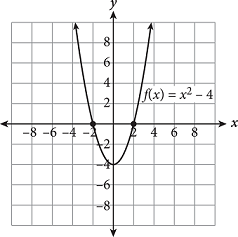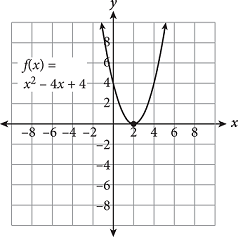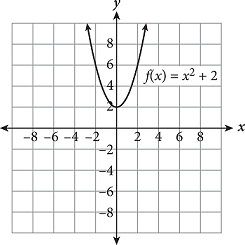PSAT/NMSQT Prep 2020 - Princeton Review 2020
Quadratics
Passport to advanced math
Learning Objectives
After completing this chapter, you will be able to:
· Solve a quadratic equation by factoring
· Recognize the classic quadratics
· Solve a quadratic equation by completing the square
· Solve a quadratic equation by applying the quadratic formula
· Relate properties of a quadratic function to its graph and vice versa
· Solve a system of one quadratic and one linear equation
60/600 SmartPoints®
How Much Do You Know?
Directions
Try the questions that follow. Show your work so that you can compare your solutions to the ones found in the Check Your Work section immediately after this question set. The “Category” heading in the explanation for each question gives the title of the lesson that covers how to solve it. If you answered the question(s) for a given lesson correctly, and if your scratchwork looks like ours, you may be able to move quickly through that lesson. If you answered incorrectly or used a different approach, you may want to take your time on that lesson.
1. If x 2 + 8x = 48 and x > 0, what is the value of x — 5 ?
1. —9
2. —1
3. 4
4. 7
2. What is the absolute value of the difference between the roots of 4x2 — 36 = 0 ?
1. —6
2. 0
3. 3
4. 6
3. Which of the following is equivalent to x2 — 6x + 10 = 0 ?
1. ![]()
2. 
3. 
4. ![]()
![]()
4. The quadratic above has only one distinct, real root. What is the value of c ?
1. —8
2. —4
3. 4
4. 8
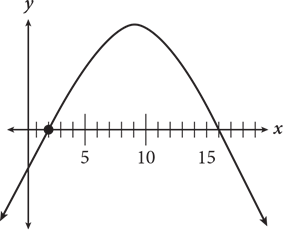
5. Which of the following equations could represent the above graph?
1. y = −x2 + 18x − 32
2. y = −x2 + 14x − 32
3. y = x2 − 14x − 32
4. y = x2 + 18x + 32
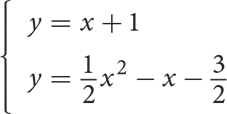
6. If (a, b) is a solution to the system of equations shown, what is the value of a, given that a > 0 ?

7.
Check Your Work
1. B
Difficulty: Medium
Category: Solving Quadratics by Factoring
Strategic Advice: When finding solutions to a quadratic equation, always start by rewriting the equation to make it equal to 0 (unless both sides of the equation are already perfect squares). Then, take a peek at the answer choices—if they are all integers that are easy to work with, then factoring is probably the quickest method for solving the equation. If the answers include messy fractions or square roots, then using the quadratic formula may be a better choice.
Getting to the Answer: To make the equation equal to 0, subtract 48 from both sides to get x 2 + 8x − 48 = 0. The answer choices are all integers, so factor the equation. Look for two numbers whose product is −48 and whose sum is 8. The two numbers are − 4 and 12, so the factors are (x − 4) and (x + 12). Set each factor equal to 0 and solve to find that x = 4 and x = −12. The question states that x > 0, so x must equal 4. Before selecting an answer, don’t forget to check that you answered the right question—the question asks for the value of x − 5, not just x, so the correct answer is 4 − 5 = −1. (B) is correct.
2. D
Difficulty: Hard
Category: Classic Quadratics
Getting to the Answer: Notice that this is a difference of squares, so use the formula a2 − b2 = (a + b)(a — b) with a2 = 4x2. This means that a = 2x and b2 = 36, so b = 6. Therefore, (2x + 6)(2x − 6) = 0. Set both equal to 0 and solve:

Remember that the question asks for the absolute difference of the roots. Think of a number line and count from −3 to 3. The difference is 6. Alternatively, just take the absolute value of the difference between the roots:
![]()
Thus, (D) is correct.
3. A
Difficulty: Medium
Category: Completing the Square
Getting to the Answer: The format of the answer choices makes completing the square the best approach for this problem. Since the first term has a constant of 1, that makes completing the square more straightforward. Make sure to move the constant term to the right side of the equation before dividing the x term constant by 2 and squaring. Also, make sure that the squared term contains a negative constant since the x term in the original quadratic is negative:
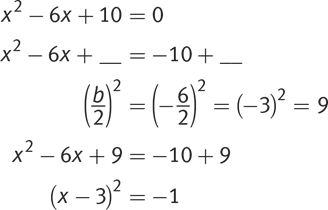
Therefore, (A) is correct. Note that (C) is the result if you forgot to divide b by 2.
4. D
Difficulty: Medium
Category: The Quadratic Formula
Getting to the Answer: In order for the quadratic to have only one root, the discriminant must be equal to 0. Plug the numbers given into the discriminant, set it equal to 0, and solve for c:
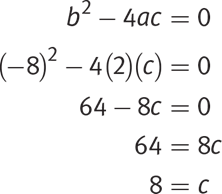
Therefore, (D) is correct.
5. A
Difficulty: Hard
Category: Graphs of Quadratics
Strategic Advice: Use the visual information in the graph to eliminate answers quickly. A negative coefficient of the squared term means that the graph opens downward. The roots of a quadratic are where the graph crosses the x-axis.
Getting to the Answer: Because the quadratic opens downward, the x2-coefficient must be negative, so you can eliminate (C) and (D). According to the graph, the roots are x = 2 and x = 16. That means that the factored form of the quadratic will be either (−x + 2)(x − 16) or (x − 2)(−x + 16). These factored forms are actually equivalent because (—x + 2) = (—1)(x — 2) and (x — 16) = (—1)(—x + 16), which means:

Use FOIL on one of them to see if it matches the expanded form of the quadratic in (A) or (B):

Thus, (A) is correct.
Another approach would be to use Picking Numbers. After eliminating (C) and (D) for having upward parabolas and calculating the roots, simply pick the more manageable of the two x-intercepts, x = 2, and plug it into the equations in (A) and (B) to see which one results in y = 0:
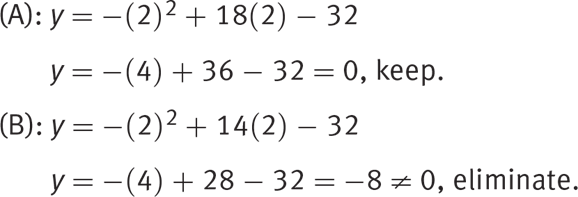
(A) is indeed correct.
6. 5
Difficulty: Hard
Category: Systems of Quadratic and Linear Equations
Getting to the Answer: Unfortunately, this is a non-calculator question, so you’ll need to solve the system using substitution, rather than by graphing it on your calculator. Substitute the first equation for y into the second. Before you solve for x, multiply the whole equation by 2 to remove the fractions. Then, set the whole equation equal to 0 and factor:
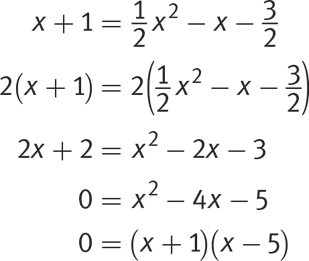
Now, set each factor equal to 0 and solve to find that x = −1 and x = 5. The question asks only for a, which is the x-coordinate of the solution, so you do not need to substitute x back into an equation and solve for y. The two possible values of a are −1 and 5. Because the question specifies that a > 0, the answer must be 5. Grid in 5.
Solving Quadratics by Factoring
Learning Objective
After this lesson, you will be able to:
· Solve a quadratic equation by factoring
To answer a question like this:
1. If x 2 + x = 20 and x < 0, what is the value of x − 7 ?
1. —12
2. —5
3. 5
4. 12
You need to know this:
A quadratic expression is a second-degree polynomial—that is, a polynomial containing a squared variable. You can write a quadratic expression as ![]() .
.
The FOIL acronym (which stands for First, Outer, Inner, Last) will help you remember how to multiply two binomials: multiply the first terms together (ac), then the outer terms (ad), then the inner terms (bc), and finally the last terms (bd):
(a + b)(c + d) = ac + ad + bc + bd
FOIL can also be done in reverse if you need to go from a quadratic to its factors.
To solve a quadratic equation by factoring, the quadratic must be set equal to zero. For example:

From the binomial factors, you can find the solutions, also called roots or zeros, of the equation. For two factors to be multiplied together and produce zero as the result, one or both those factors must be zero. In the example above, either x + 8 = 0 or x − 7 = 0, which means that x = −8 or x = 7.
You need to do this:
To solve a quadratic equation by factoring:
· Set the quadratic equal to zero, so it looks like this: ax2 + bx + c = 0.
· Factor the squared term. (For factoring, it’s easiest when a, the coefficient in front of x 2, is equal to 1.)
· Make a list of the factors of c. Remember to include negatives.
· Find the factor pair that, when added, equals b, the coefficient in front of x.
· Write the quadratic as the product of two binomials.
· Set each binomial equal to zero and solve.
Explanation:
Set the equation equal to zero and factor the first term:

Next, consider factors of −20, keeping in mind that they must sum to 1, so the factor with the greater absolute value must be positive. The possibilities are 20 × −1, 10 × −2 and 5 × −4. The factor pair that sums to 1 is 5 × −4. Write that factor pair into your binomials:
![]()
Set each factor equal to zero and solve:

The question says that x < 0, so x = −5. However, you are not done. The question asks for x − 7, which is −12. Therefore, (A) is correct.
Try on Your Own
Directions
Take as much time as you need on these questions. Work carefully and methodically. There will be an opportunity for timed practice at the end of the chapter.
1. Which of the following is an equivalent form of the expression (x — 4)(x + 2) ?
1. ![]()
2. ![]()
3. ![]()
4. ![]()
2. What is the positive difference between the zeros of ![]() ?
?

3. What positive value(s) of z satisfy the equation ![]() ?
?
1. 2
2. 2 and —10
3. 4 and 2
4. None of the above
4. HINT: For Q4, is there anything you can factor out of the numerator or the denominator?
5. Which of the following is equivalent to  ?
?
1. ![]()
2. 
3. 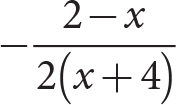
4. 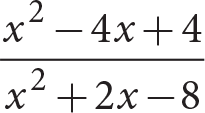
6. HINT: Begin Q5 by solving for the zeros of each answer choice.
7. If a quadratic function f (x) has solutions a and b such that a < 0, b > 0, and | b | > | a |, which of the following could be equal to f (x) ?
1. ![]()
2. ![]()
3. ![]()
4. ![]()
8.
Classic Quadratics
Learning Objective
After this lesson, you will be able to:
· Recognize the classic quadratics
To answer a question like this:
1. Which of the following expressions is equivalent to 36x 4y 6 − 4 ?
1. 6(x 4y 6 − 2)
2. −6(x2y3 + 2)
3. (6x2y2 − 2)(6x2y2 + 2)
4. (6x2y 3 − 2)(6x2y 3 + 2)
You need to know this:
Memorizing the following classic quadratics will save you time on test day:
1. ![]()
1. This is known as a “difference of squares” because it takes the form of one perfect square minus another perfect square.
2. ![]()
3. ![]()
You need to do this:
When you see a pattern that matches either the left or the right side of one of the above equations, simplify by substituting its equivalent form. For example, say you need to simplify the following:

You would substitute (a − b)(a − b) for the numerator and cancel to find that the expression simplifies to a − b:

Explanation:
The expression ![]() is a difference of perfect squares. The square root of
is a difference of perfect squares. The square root of ![]() is
is ![]() and the square root of 4 is 2, so the correct factors are
and the square root of 4 is 2, so the correct factors are  . Hence, (D) is correct.
. Hence, (D) is correct.
Try on Your Own
Directions
Take as much time as you need on these questions. Work carefully and methodically. There will be an opportunity for timed practice at the end of the chapter.
1. HINT: What can you do to make (a − b)2 in Q6 easier to work with?
2. For all a and b, what is the product of (a — b)2 and (a + b) ?
1. a2 — b2
2. a3 — b3
3. a3 — ab2 + a2b — b3
4. a3 — ab2 — a2b + b3
3. Which equation does NOT have a solution at ![]() ?
?
1. ![]()
2. ![]()
3. ![]()
4. ![]()
4. HINT: One of the given equations in Q8 is a classic quadratic.
5. A rectangle has an area of ![]() . If the width of the rectangle is
. If the width of the rectangle is ![]() , what is the length?
, what is the length?
1. ![]()
2. ![]()
3. ![]()
4. ![]()
6. A rectangular prism has a height of x, a width of 7 less than the height, and a length 14 more than the width. What is the volume of the prism?
1. ![]()
2. ![]()
3. ![]()
4. 
7. HINT: For Q10, is there any variable you can factor out from each term?
![]()
8. Which of the following expressions is equivalent to the expression above?
1. 
2. ![]()
3. 
4. 
9.
Completing the Square
Learning Objective
After this lesson, you will be able to:
· Solve a quadratic equation by completing the square
To answer a question like this:
1. Which of the following has the same roots as 30 − 8x = x2 — y?
1. y = (x − 4)2 − 30
2. y = (x − 4)2 + 30
3. y = (x + 4)2 − 46
4. y = (x + 4)2 + 46
You need to know this:
For quadratics that do not factor easily, you’ll need one of two strategies: completing the square or the quadratic formula (taught in the next lesson). To complete the square, you’ll create an equation in the form (x + h)2 = k, where h and k are constants.
As with factoring, completing the square is most convenient when the coefficient in front of the x2 term is 1.
You need to do this:
Here are the steps for completing the square, demonstrated with a simple example.
|
Step |
Scratchwork |
|
Starting point: |
x 2 + 8x − 8 = 0 |
|
1. Move the constant to the opposite side. |
x 2 + 8x = 8 |
|
2. Divide b, the x-coefficient, by 2, and square the quotient. |
|
|
3. Add the number from the previous step to both sides of the equation and factor. |
x 2 + 8x + 16 = 8 + 16
|
|
4. Take the square root of both sides. |
|
|
5. Split the result into two equations and solve each one. |
|
Explanation:
First, write the equation in standard form: y = x 2 + 8x − 30. Move the 30 to the other side to temporarily get it out of the way. Then, complete the square on the right-hand side, by finding  and adding the result to both sides of the equation:
and adding the result to both sides of the equation:
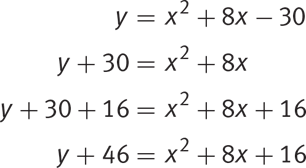
The answer choices are all written in factored form. The right side of the equation is a classic quadratic that factors as follows:

Finally, solve for y to get y = (x + 4)2 − 46, which makes (C) correct.
Try on Your Own
Directions
Take as much time as you need on these questions. Work carefully and methodically. There will be an opportunity for timed practice at the end of the chapter.
1. Which of the following equations has the same solutions as x 2 + 6x +17 = y ?
1. y = (x — 3)2 — 26
2. y = (x — 3)2 + 8
3. y = (x + 3)2 + 8
4. y = (x + 3)2 + 17
2. Which of the following are roots for x2 + 10x — 8 = 0 ?
1. ![]()
2. ![]()
3. ![]()
4. ![]()
3. Which of the following is equivalent to x2 + 4x + 16 = 0 ?
1. 
2. 
3. 
4. 
4. HINT: What can you divide each term by to make the equation in Q14 easier to work with?
5. What value of x satisfies the equation ![]() ?
?
1. ![]()
2. ![]()
3. 3
4. ![]()
6.
The Quadratic Formula
Learning Objectives
After this lesson, you will be able to:
· Solve a quadratic equation by applying the quadratic formula
To answer a question like this:
4x 2 − 7x − 4 = 0
1. Which of the following values of x satisfy the equation above?
1. 1 and 4
2.  and
and 
3.  and
and 
4. No real solutions
You need to know this:
The quadratic formula can be used to solve any quadratic equation. It yields solutions to a quadratic equation that is written in standard form, ax 2 + bx + c = 0:

The ± sign that follows −b indicates that you will have two solutions, so remember to find both.
The expression under the radical (b2 − 4ac) is called the discriminant, and its value determines the number of real solutions. If the discriminant is positive, the equation has two distinct real solutions. If the discriminant is equal to 0, there is only one distinct real solution. If the discriminant is negative, there are no real solutions because you cannot take the square root of a negative number.
The arithmetic can get complicated, so reserve the quadratic formula for equations that cannot be solved by factoring and those in which completing the square is difficult because ![]()
You need to do this:
Get the quadratic equation into the form ax 2 + bx + c = 0. Then, substitute a, b, and c into the quadratic formula and simplify.
Explanation:
In the given equation, a = 4, b = −7, and c = −4. Plug these values into the quadratic formula and simplify:
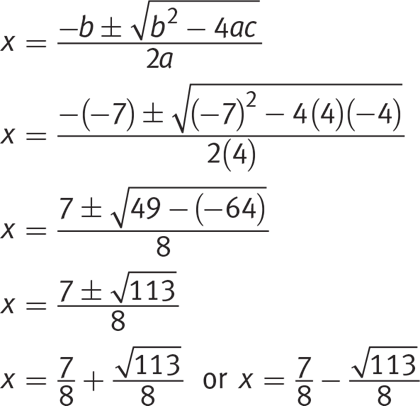
The correct answer is (C).
Try on Your Own
Directions
Take as much time as you need on these questions. Work carefully and methodically. There will be an opportunity for timed practice at the end of the chapter.
1. HINT: For Q15, what does it mean if there are no zeros on the graph of a quadratic equation?
2.
1. Which of the quadratic functions shown has no zeros?
2. 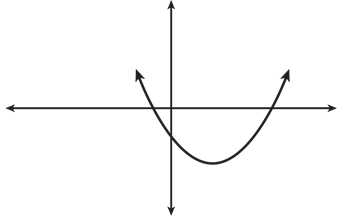
3. 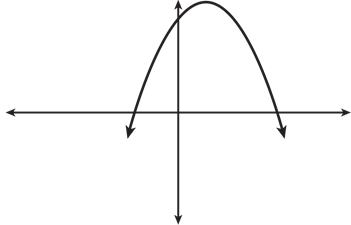
4. 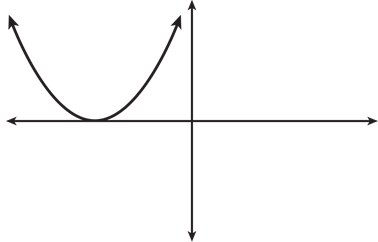
5. 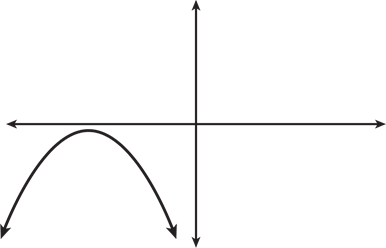
3. HINT: For Q16, what does the expression under the square root sign in the quadratic formula indicate?
4. Which of the following are the real values of x that satisfy the equation 3x 2 + 2x + 4 = 5x ? ?
1. 3 and −2
2. ![]() and
and 
3. 0
4. The equation has no real solutions.
5. Which of the following are the roots of the equation x 2 + 8x — 3 = 0 ?
1. ![]()
2. ![]()
3. ![]()
4. ![]()
6. HINT: HINT: For Q18, remember that for a parabola to have two real solutions, the discriminant b2 − 4ac must be greater than zero.
7. Which quadratic equation has two real solutions?
1. 
2. 
3. 
4. 

8. What are the roots of the above equation?
1. 
2. 
3. 
4. 
9.
Graphs of Quadratics
Learning Objective
After this lesson, you will be able to:
· Relate properties of a quadratic function to its graph and vice versa
To answer a question like this:
1. Which of the following statements is NOT true, given the equation y = (4x − 3)2 + 6 ?
1. The vertex is (3, 6).
2. The y-intercept is (0, 15).
3. The parabola opens upward.
4. The graph does not cross the x-axis.
You need to know this:
A quadratic function is a quadratic equation set equal to y or f (x) instead of 0. Remember that the solutions (also called “roots” or “zeros”) of any polynomial function are the same as the x-intercepts. To solve a quadratic function, substitute 0 for y, or f (x), then solve algebraically. Alternatively, you can plug the equation into your graphing calculator and read the x-intercepts from the graph.

The graph of every quadratic equation (or function) is a parabola, which is a symmetric U-shaped graph that opens either upward or downward. To determine which way a parabola will open, examine the value of a in the equation. If a is positive, the parabola will open upward. If a is negative, it will open downward. Take a look at the examples above to see this graphically.
Like quadratic equations, quadratic functions will have zero, one, or two distinct real solutions, corresponding to the number of times the parabola crosses (or touches) the x-axis, as shown in the illustrations below. Graphing is a powerful way to determine the number of solutions a quadratic function has.
|
Two Real Solutions |
One Real Solution |
No Real Solutions |
|
|
|
|
There are three algebraic forms that a quadratic equation can take: standard, factored, and vertex. Each is provided in the following table along with the graphical features that are revealed by writing the equation in that particular form.
|
Standard |
Factored |
Vertex |
|
y = ax2 + bx + c |
y = a(x − m)(x − n) |
y = a(x − h)2 + k |
|
The y-intercept is c. |
Solutions are m and n. |
The vertex is (h, k). |
|
In real-world contexts, starting quantity is c. |
The x-intercepts are m and n. |
The minimum/maximum of the function is k. |
|
This is the format used to solve via quadratic formula. |
The vertex is halfway between m and n. |
The axis of symmetry is given by x = h. |
You’ve already seen standard and factored forms earlier in this chapter, but vertex form might be new to you. In vertex form, a is the same as the a in standard form, and h and k are the coordinates of the vertex (h, k). If a quadratic function is not in vertex form, you can still find the x-coordinate of the vertex by plugging the appropriate values into the equation  , which is also the equation for the axis of symmetry (see graph that follows). Once you determine h, plug this value into the quadratic function and solve for y to determine k, the y-coordinate of the vertex.
, which is also the equation for the axis of symmetry (see graph that follows). Once you determine h, plug this value into the quadratic function and solve for y to determine k, the y-coordinate of the vertex.
The equation of the axis of symmetry of a parabola is x = h, where h is the x-coordinate of the vertex.
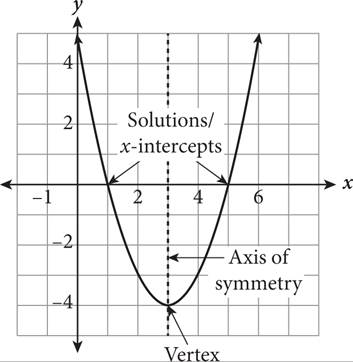
You need to do this:
· To find the vertex of a parabola, get the function into vertex form, y = a(x − h)2 + k, or use the formula  .
.
· To find the y-intercept of a quadratic function, plug in 0 for x.
· To determine whether a parabola opens upward or downward, look at the coefficient of a. If a is positive, the parabola opens upward. If negative, it opens downward.
· To determine the number of x-intercepts, set the quadratic function equal to 0 and solve or examine its graph. (Quadratic function questions show up on both the no-calculator and calculator sections of the PSAT.)
Explanation:
Be careful: the equation looks like vertex form, y = a(x − h)2 + k, but it’s not quite there because the x has a coefficient of 4 inside the parentheses. You could rewrite the equation in vertex form, but this would involve squaring the quantity in parentheses and then completing the square, which would take quite a bit of time. Alternatively, you could notice that the smallest possible value for y in this function is 6, which happens when the squared term, (4x − 3)2, equals zero. To check (A), find the x-value when y = 6:
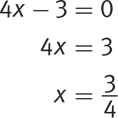
So the vertex is  , not (3, 6). It follows that (A) is false and is the correct answer.
, not (3, 6). It follows that (A) is false and is the correct answer.
For the record:
Choice (B): Substitute 0 for x and simplify to find that the y-intercept is indeed (0, 15). Eliminate.
Choice (C): The squared term is positive, so the parabola does open upward. Eliminate.
Choice (D): Because the parabola opens upward and the vertex is at y = 6, above the x-axis, the parabola cannot cross the x-axis. This statement is true as well, so it can also be eliminated which confirms that (A) is correct.
Try on Your Own
Directions
Take as much time as you need on these questions. Work carefully and methodically. There will be an opportunity for timed practice at the end of the chapter.
1. HINT: For Q20, which form of a quadratic would you use to find its solutions?
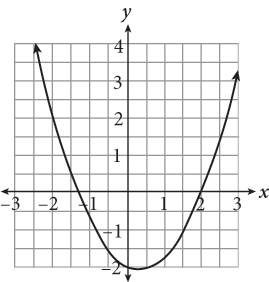
2. The following quadratic equations are all representations of the graph shown. Which equation enables the easiest calculation of the x-intercepts of the graph?
1. 
2. 
3. 
4. 
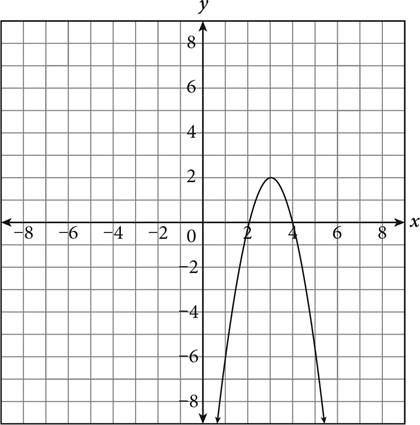
3. Which of the following represents the function shown in the graph?
1. ![]()
2. ![]()
3. ![]()
4. ![]()
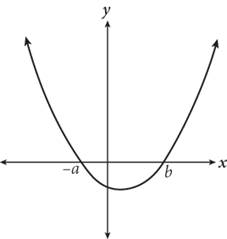
4. If the distance from —a to b in the figure shown is 10, which of the following could be the factored form of the graph’s equation?
1. y = (x — 7)(x — 3)
2. y = (x — 7)(x + 3)
3. y = (x — 8)(x — 2)
4. y = (x — 1)(x + 10)
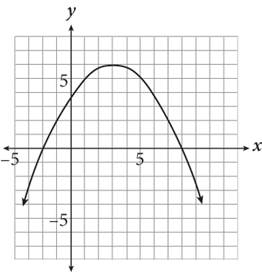
5. If y = ax 2 + bx + c represents the equation of the graph shown in the figure, which of the following statements is NOT true?
1. The value of a is a negative number.
2. The value of c is a negative number.
3. The y-value is increasing for x < 3 and decreasing for x > 3.
4. The zeros of the equation are x = −2 and x = 8.
6. HINT: Begin Q24 by considering what the x-intercepts would represent in terms of the ball’s trajectory.
7. If a catapult is used to throw a lead ball from ground level, the path of the ball can be modeled by a quadratic equation, y = ax 2 + bx + c, where x is the horizontal distance that the ball travels and y is the height of the ball. If one of these catapult-launched lead balls travels 150 feet before hitting the ground and reaches a maximum height of 45 feet, which of the following equations represents its path?
1. y = −0.008x 2 + 1.2x
2. y = −0.008x 2 — 150x
3. y = 45x 2 + 150x
4. y = 125x 2 + 25x
8. HINT: Consider extending the graph in Q25. Don’t forget to do the unit conversion.
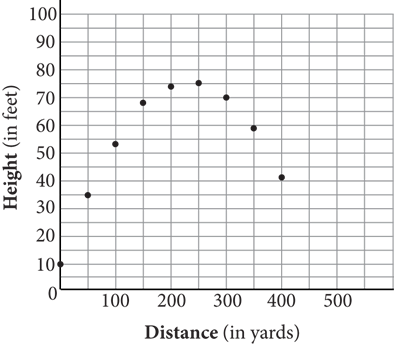
9. The figure above shows the partial trajectory of a cannonball shot into the air. Assuming that the cannonball lands at a point where the height is 0, approximately how many feet farther did the cannonball travel horizontally than vertically upward? (1 yard = 3 feet)
1. 335
2. 425
3. 935
4. 1,390
10.
Systems of Quadratic and Linear Equations
Learning Objective
After this lesson, you will be able to:
· Solve a system of one quadratic and one linear equation
To answer a question like this:
1. In the xy-plane, two equations, ![]() and
and ![]() , intersect at points (0, 5) and (a, b). What is the value of −b ?
, intersect at points (0, 5) and (a, b). What is the value of −b ?
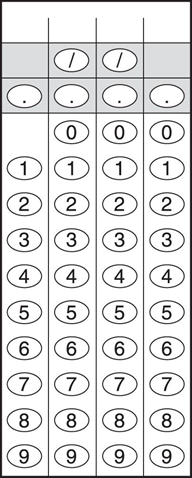
You need to know this:
You can solve a system of one quadratic and one linear equation by substitution, exactly as you would for a system of two linear equations. Alternatively, if the question appears on the calculator section, you can plug the system into your graphing calculator.
You need to do this:
· Isolate y in both equations.
· Set the equations equal to each other.
· Put the resulting equation into the form ![]() .
.
· Solve this quadratic by factoring, completing the square, or using the quadratic formula. (You are solving for the x-values at the points of intersection of the original two equations.)
· Plug the x-values you get as solutions into one of the original equations to generate the y-values at the points of intersection. (Usually, the linear equation is easier to work with than the quadratic.)
Explanation:
Start by isolating y in both equations to get ![]() and
and ![]() . Now, set the right sides of the equations equal and solve for x:
. Now, set the right sides of the equations equal and solve for x:
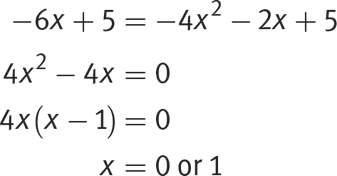
The question says that (0, 5) is one point of intersection for the two equations and asks for the y-value at the other point of intersection, so plug x = 1 into either of the original equations and solve for y. Using the linear equation will be faster:

So (a, b) = (1, −1). The question asks for −b, so grid in 1.
Try on Your Own
Directions
Take as much time as you need on these questions. Work carefully and methodically. There will be an opportunity for timed practice at the end of the chapter.
1. HINT: You can take a shortcut in Q26. There’s no need to isolate y in the second equation.
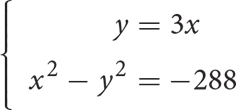
2. If (x, y) is a solution to the system of equations shown here, what is the value of x 2 ?
1. 6
2. 36
3. 144
4. 1,296
3. HINT: Don’t try to find solutions to all the systems in the answer choices of Q27. Backsolve instead.
4. One of the x-coordinates of the solutions to a system of equations is −8. Which of the following could be the system?
1. 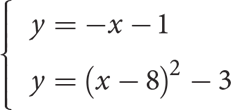
2. 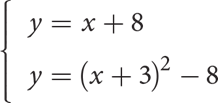
3. 
4. 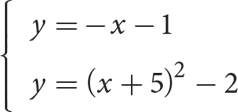
5. HINT: For Q28, what does it mean when a system of equations has only one solution?
6. Which system of equations has only one solution?
1. 
2. 
3. 
4. 
7. Will the graph of  intersect the graph of
intersect the graph of ?
?
1. Yes, only at the vertex of the parabola
2. Yes, once on each side of the vertex
3. Yes, twice to the right of the vertex
4. No, the graphs will not intersect.
On Test Day
Remember that the PSAT doesn’t ask you to show your work. If you find the algebra in a question challenging, there is often another way to get to the answer.
Try to answer this question first by setting the two functions equal to each other and then by plugging the values of one of the intersection points into one of the functions. Which approach do you find easier? There’s no right or wrong answer—just remember your preferred approach and try it first if you see a question like this on test day.

1. The functions f(x) = 2x2 − 5 and g(x) = 6x2 — 7 are graphed in the xy-plane above. The points where the two functions intersect are (z, —4) and (—z, —4). What is the value of z ?
1. ![]()
2. 
3. 0.8
4. 1.2
2.
The correct answer and both ways of solving can be found at the end of this chapter.
How Much Have You Learned?
Directions
For testlike practice, give yourself 15 minutes to complete this question set. Be sure to study the explanations, even for questions you got right. They can be found at the end of this chapter.
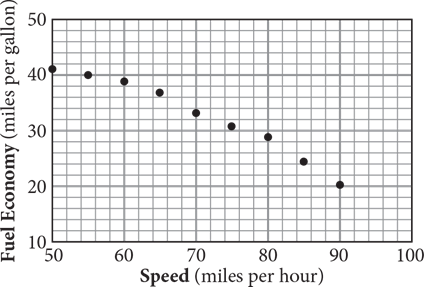
1. A car’s fuel economy generally increases as its speed increases, but past a certain speed, it starts to drop, as depicted for a particular car in the graph above. What is the best estimate of this car’s fuel economy, in miles per gallon, at 100 miles per hour?
1. 0
2. 10
3. 17
4. 41
2. The x-intercepts of the equation y = x2 — 9x + 20 are m and n, where m > n. What is the value of m ?
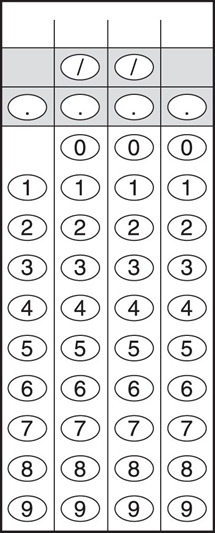
3. Shawna throws a baseball into the air. The equation h = −5(t 2 − 4t + 4)+ 22 represents the height of the ball in meters t seconds after it is thrown. Which of the following equations could represent the height of a second ball that was thrown by Meagan, if Meagan’s ball did not go as high as Shawna’s ball?
1. h = −10(t − 4) 2 + 27
2. h = −10(t − 2) 2 + 25
3. h = −8(2t — 1)2 + 23
4. h = −5(t — 2)2 + 21
4. Which of the following equations could represent a parabola that has a minimum value of —3 and whose axis of symmetry is the line x = 2 ?
1. y = (x — 3)2 + 2
2. y = (x + 3)2 + 2
3. y = (x — 2)2 — 3
4. y = (x + 2)2 — 3
5. Which of the following is a solution to the equation ![]() ?
?
1. —3
2. ![]()
3. 4
4. 7
6. Which of the following is an equivalent form of 4x2 — 8x + 64 = 0 ?
1. ![]()
2. ![]()
3. ![]()
4. ![]()
7. Which of the following is equivalent to 64x2 — 81y2 ?
1. (8x + 9y)(8x — 9y)
2. (9x + 8y)(9x — 8y)
3. (8x + 9y)2
4. (8x — 9y)2
8. Which of the following quadratics has only one real solution?
1. 4x2 = 3x − 8
2. 10x = 2 −x2
3. 7x2 + 2x — 5 = 0
4. 3x2 — 6x + 3 = 0
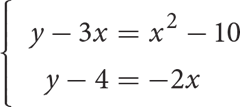
9. What is the absolute difference of the values of x for the solutions to the system of equations above?
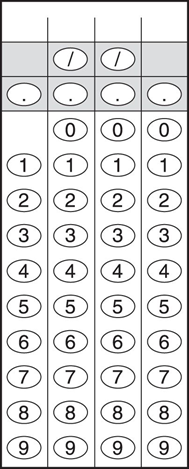
10.Which of the following coordinates is the vertex of the parabola y = x2 — 14x + 3 ?
1. (7, —46)
2. (—7, —46)
3. (14, —193)
4. (—14, —193)
11.
Reflect
Directions: Take a few minutes to recall what you’ve learned and what you’ve been practicing in this chapter. Consider the following questions, jot down your best answer for each one, and then compare your reflections to the expert responses on the following page. Use your level of confidence to to determine what to do next.
What features in a quadratic equation should you look for to decide whether to factor, complete the square, or apply the quadratic formula?
Which constant in the vertex form of a quadratic function gives its maximum or minimum?
Which form of a quadratic equation gives its y-intercept?
Which form of a quadratic equation gives its x-intercepts, assuming the equation has two real roots?
How do you solve a system of one linear and one quadratic equation?
EXPERT RESPONSES
What features in a quadratic equation should you look for to decide whether to factor, complete the square, or apply the quadratic formula?
Get the equation into standard form. If the coefficient in front of the squared term is 1, try factoring, but don’t spend longer than about 15 seconds on the attempt. If you can’t get the quadratic factored quickly, look at the coefficient on the middle term: if it is even, completing the square will be an efficient approach. Finally, the quadratic formula will work for any quadratic, no matter what the coefficients are.
Which constant in the vertex form of a quadratic function gives its maximum or minimum?
The vertex form is ![]() . The constant k is the y‑value at the vertex, which occurs at the maximum or minimum.
. The constant k is the y‑value at the vertex, which occurs at the maximum or minimum.
Which form of a quadratic equation gives its y-intercept?
The standard form, ![]() . The y-intercept is given by c.
. The y-intercept is given by c.
Which form of a quadratic equation gives its x-intercepts, assuming the equation has two real roots?
The factored form, ![]() . The x-intercepts are at x = m and x = n.
. The x-intercepts are at x = m and x = n.
How do you solve a system of one linear and one quadratic equation?
Put the linear equation in the form ![]() and the quadratic in the form
and the quadratic in the form ![]() . Set the right sides of the equations equal to each other and solve.
. Set the right sides of the equations equal to each other and solve.
NEXT STEPS
If you answered most questions correctly in the “How Much Have You Learned?” section, and if your responses to the Reflect questions were similar to those of the PSAT expert, then consider Quadratics an area of strength and move on to the next chapter. Come back to this topic periodically to prevent yourself from getting rusty.
If you don’t yet feel confident, review those parts of this chapter that you have not yet mastered. In particular, study the table describing the different forms of quadratics in the Graphs of Quadratics lesson. Then, try the questions you missed again. As always, be sure to review the explanations closely.
Answers and Explanations
1. B
Difficulty: Easy
Getting to the Answer: FOIL the binomials ![]() : First: (x)(x) = x 2. Outer: (2)(x). Inner: (−4)(x). Last: (2)(−4) = −8. Add all the terms together and combine like terms:
: First: (x)(x) = x 2. Outer: (2)(x). Inner: (−4)(x). Last: (2)(−4) = −8. Add all the terms together and combine like terms: ![]() . The correct answer is (B).
. The correct answer is (B).
2. 0
Difficulty: Easy
Getting to the Answer: All the question is really asking you to do is solve for the zeros and subtract them:
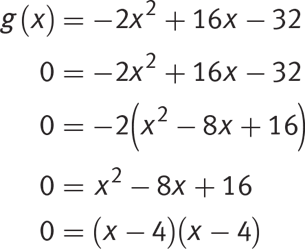
The quadratic has only one unique solution, 4, so the positive difference between the zeros of the function is 0. Grid in 0.
3. A
Difficulty: Easy
Getting to the Answer: Rearrange the equation first so you can factor 4 out. From there, divide by 4, then factor as usual:
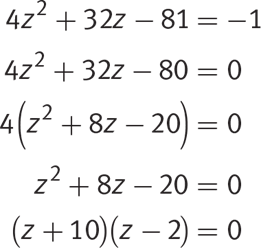
Keep in mind that while z is equal to −10 or 2, the problem asks only for the positive value, which is (A). Reading carefully, you could have eliminated (B) before doing any calculations because it includes a negative value.
4. C
Difficulty: Medium
Strategic Advice: None of the choices has a remainder, suggesting that you probably will not need polynomial division for this question. Try factoring the numerator and denominator to see if something will cancel out.
Getting to the Answer: Start by factoring out a 2 in the denominator to make that quadratic a bit simpler. Once there, factor to reveal an (x − 2) term that will cancel out:

Unfortunately, none of the answer choices match. Try factoring −1 out of the numerator:

The correct answer is (C).
5. B
Difficulty: Hard
Getting to the Answer: Set each answer choice equal to zero and factor to determine which one meets the criteria posed in the question: the solutions must have different signs and the positive solution must have a greater absolute value than the negative solution.
(A): 
The solutions are 2 and −3. They have different signs, but the negative solution has the greater absolute value. Eliminate (A).
(B): 
This time, the solutions are −2 and 3, so the criteria are met. (B) is correct.
For the record:
(C): 
This has the same solutions as (A). Eliminate (C).
(D): ![]()
The solutions are 0 and 2. Eliminate (D) and confirm that (B) is correct.
1. D
Difficulty: Medium
Getting to the Answer: Expand the first factor to take advantage of the difference of squares, and then use FOIL to multiply the two factors that remain:
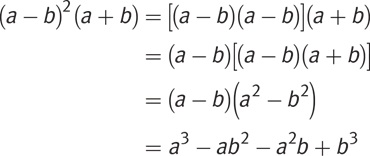
This matches (D).
2. A
Difficulty: Medium
Getting to the Answer: This question can be solved two ways. One is to factor each choice and solve for the solutions, and whichever does not have a solution of x = −4 is correct. Another way is to plug in x = −4 for each choice; if the equation does not equal 0, then that choice is correct. Luckily, plugging x = −4 into the first choice results in 64 and not 0. Choice (A) factored would be (x − 4)2, so its only unique root is x = 4. Hence, (A) is correct.
3. B
Difficulty: Medium
Getting to the Answer: Start by noticing that the area equation is a difference of perfect squares. Use the difference of squares formula (a2 − b2) = (a + b)(a − b) where (x4 − 196) = (x2 + 14)(x2 − 14). Because area is length times width (A = lw) and the width is x2 — 14, the length must be x2 + 14, so (B) is correct.
4. D
Difficulty: Medium
Getting to the Answer: The volume equation for a rectangular prism is V = lwh, so work with one variable at a time and then plug all of the dimensions in. The height will just be, x, so h = x. The width is 7 less than the height, so subtract seven from the height, or x, which gives w = x − 7. The length is 14 more than the width, so l = (x − 7) + 14 = x + 7. Plug all of these values into the volume formula and recognize a difference of squares to get x(x − 7)(x + 7) = x(x2 − 49). Thus, (D) is correct.
5. B
Difficulty: Medium
Getting to the Answer: Factor out the common term p2 to get p2(16m2 + 72mz + 81z2). Eliminate (D), which is equivalent until the final term. Notice that 16m2 +72mz + 81z2 is a classic quadratic:
![]()
So the original expression is equal to p2(4m + 9z)2. Thus, (B) is correct. Another way to solve would have been to FOIL, or distribute, each choice and see which one results in the given expression.
1. C
Difficulty: Medium
Strategic Advice: Equations that are equivalent have the same solutions, so you are looking for the equation that is simply written in a different form. You could expand each of the equations in the answer choices, but unless you get lucky, this strategy will use up quite a bit of time. The answer choices are written in vertex form, so use the method of completing the square to rewrite the equation given in the question stem.
Getting to the Answer: First, subtract the constant, 17, from both sides of the equation. To complete the square on the right-hand side, find  , and add the result to both sides of the equation:
, and add the result to both sides of the equation:
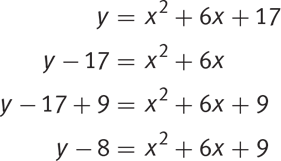
Next, factor the right-hand side of the equation (which should be a perfect square trinomial), and rewrite it as a square. Finally, solve for y:
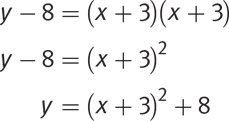
This matches (C).
2. B
Difficulty: Medium
Getting to the Answer: Since the first term has a constant of 1, completing the square can be used right away. Make sure to move the constant term to the right side of the equation before dividing the x term by 2 and squaring:
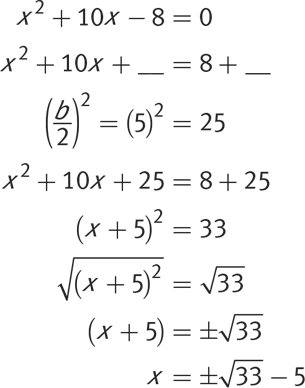
Therefore, (B) is correct.
3. D
Difficulty: Medium
Getting to the Answer: Since the first term has a constant of 1, completing the square can be used right away. Make sure to move the constant term to the right side of the equation before dividing the x term constant by 2 and squaring:
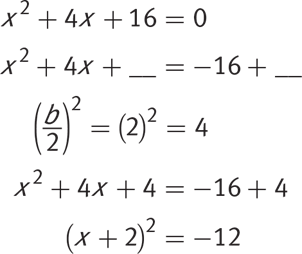
Therefore, (D) is correct.
4. A
Difficulty: Hard
Getting to the Answer: When something doesn’t factor cleanly, consider completing the square or using the quadratic formula. Start by dividing the entire equation by 4 so that the x2—coefficient is 1:
![]() →
→ ![]()
Factoring won’t work here. The coefficient b is even, so try completing the square:
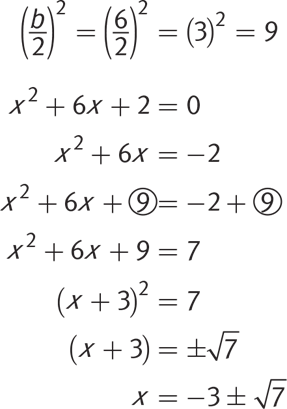
The question asks for just one solution, so (A) is the correct answer.
1. D
Difficulty: Easy
Getting to the Answer: There are no zeros for choice (D) because the parabola never intersects or touches the x-axis. The discriminant of the quadratic formula for choice (D) will be negative because there are no real zeros.
There is a pair of zeros for choices (A) and (B). There is one zero for choice (C).
2. D
Difficulty: Medium
Strategic Advice: When factoring isn’t easy, try a different approach. If you were able to use a calculator, the fastest method might be to graph the function. Because this is a no-calculator question, use the quadratic formula.
Getting to the Answer: The first step in answering the question is to manipulate the equation so that it’s equal to 0:

Now, solve using the quadratic formula:
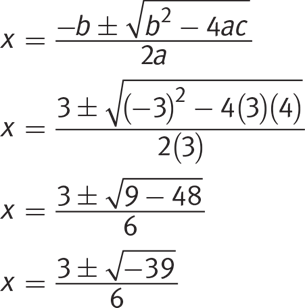
When you solve using the quadratic formula, you get a negative number under the square root, which means there are no real solutions. The correct answer is (D).
Although you couldn’t use a graphing calculator for this question, for the record, if you could graph the function, you’d see that the graph does not cross the x-axis, which means no real solutions:
![]()
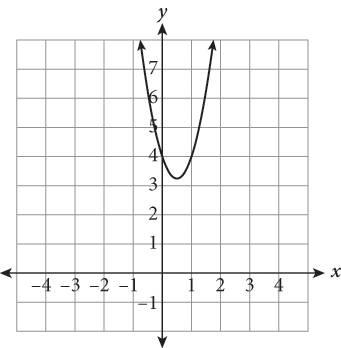
(D) is indeed correct.
3. A
Difficulty: Hard
Strategic Advice: The roots of an equation are the same as its solutions. The equation doesn’t factor using reverse FOIL, so you’ll have to use a different method to find the solutions. The equation is already written in the form y = ax 2 + bx + c, and the coefficients are fairly small, so using the quadratic formula is probably the quickest method.
Getting to the Answer: Note the values that you’ll need: a = 1, b = 8, and c = −3. Then, substitute these values into the quadratic formula and simplify:
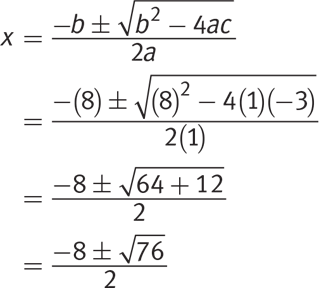
This is not one of the answer choices, which tells you that you’ll need to simplify the radical, but before you do, you can eliminate (C) and (D) because the non-radical part of the solutions is  , not 4. To simplify the radical, look for a perfect square that divides into 76 and take its square root:
, not 4. To simplify the radical, look for a perfect square that divides into 76 and take its square root:
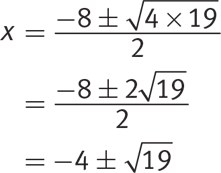
This matches (A).
4. B
Difficulty: Medium
Getting to the Answer: The discriminant is part of the quadratic formula. When the discriminant is negative, there are no real solutions to the equation because the square root of a negative number is not a real number. When the discriminant is 0, there is only one solution. For there to be two real solutions, the discriminant, b2 − 4ac, must be greater than 0.
(A): a = 2, b = 4, c = 2. The discriminant is 42 − 4(2)(2) = 16 − 16 = 0, so this has one real solution. Eliminate (A).
(B): a = 5, b = 5, c = −5. The discriminant is 52 − (4)(5)(−5) = 25 + 100 = 125, so choice (B) must have two real solutions and is correct.
For the record, the discriminant of (C) is −75 and the discriminant of (D) is 0.
5. A
Difficulty: Medium
Getting to the Answer: Since the answer choices have radicals, factoring the equation would be extremely difficult. Use the quadratic formula to find the roots of the equation:
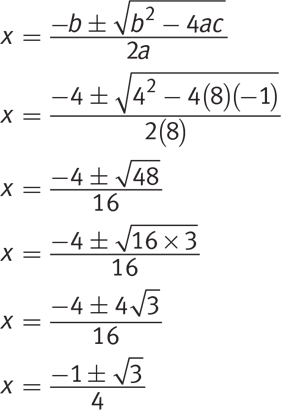
This matches (A).
1. D
Difficulty: Medium
Strategic Advice: Quadratic equations can be written in several forms, each of which reveals something important about the graph. For example, the vertex form of a quadratic equation, y = a(x — h)2 + k, gives the minimum or maximum y-value of the function, k, while the standard form, y = ax 2 + bx + c, shows the y-intercept, c.
Getting to the Answer: The factored form of a quadratic equation makes it easiest to calculate the solutions to the equation, which graphically represent the x-intercepts. Choice (D) is the only equation written in factored form and therefore must be correct. You can set each factor equal to 0 and quickly solve to find that the x-intercepts of the graph are ![]() and x = 2, which agree with the graph. (Note that each unit on the graph is 0.5.)
and x = 2, which agree with the graph. (Note that each unit on the graph is 0.5.)
2. B
Difficulty: Medium
Getting to the Answer: The parabola opens downward, so the a term should be negative. Unfortunately, all the choices have a negative a term, so you’re not able to eliminate any of them. All of the choices appear to be in vertex form, so take a look at the graph: the vertex appears to be at (3, 2); only (A) and (B) match this. To decide between them, plug in some values from points on the graph, such as the two x-intercepts, (2, 0) and (4, 0). Check if f(2) = 0 for (A): −((2) − 3)2 + 2 = −(−1)2 + 2 = −(1) + 2 = 1. Eliminate (A) because f(2) ≠ 0. Only (B) is left and is correct. For this equation, both x = 2 and x = 4 produce a result of f(x) = 0.
3. B
Difficulty: Medium
Getting to the Answer: According to the graph, one x-intercept is to the left of the y-axis and the other is to the right. This tells you that one x-intercept has a positive x-value and the other x-intercept has a negative x-value so you can immediately eliminate choices (A) and (C) because both factors have the same sign. To choose between choices (B) and (D), find the x-intercepts by setting each factor equal to 0 and solving for x. In choice (B), the x-intercepts are 7 and −3. In choice (D), the x-intercepts are 1 and −10. Choice (B) is correct because the x-intercepts are exactly 10 units apart, while the x-intercepts in choice (D) are 11 units apart. Alternatively, given that the distance between the two intercepts is 10 units, you could have just found the choice with the two factors for which the positive difference between the numerical terms is 10: 3 −(−7) = 10.
4. B
Difficulty: Medium
Strategic Advice: The coefficients are given as unknowns, so you’ll need to think about how their values affect the graph. You’ll need to recall certain vocabulary. Recall that increasing means rising from left to right, while decreasing means falling from left to right, and zero is another way of saying x-intercept. Compare each statement to the graph to determine whether it is true, eliminating choices as you go. Remember, you are looking for the statement that is NOT true.
Getting to the Answer: The parabola opens downward, so a must be negative, which means you can eliminate (A). When a quadratic equation is written in standard form, c is the y-intercept of the parabola. According to the graph, the y-intercept is above the x-axis and is therefore positive, so the statement in (B) is false, making it the correct answer.
For the record, (C) is true because the graph rises from left to right until you get to x = 3, and then it falls. Choice (D) is true because the zeros are the same as the x-intercepts, and the graph does intersect the x-axis at −2 and 8.
5. A
Difficulty: Hard
Getting to the Answer: Begin by considering the shape of the parabola formed by the path of the ball: because the ball starts and ends at ground level (y = 0) and travels a horizontal distance of 150 feet (x = 150), it must have x-intercepts of (0, 0) and (150, 0). In addition, the question tells you that it reaches a maximum height of 45 feet (y = 45) and, because the vertex is half-way between the two x-intercepts, the vertex must be at (75, 45). The vertex is above the x-intercepts, so this is a downward parabola. You can immediately eliminate choices (C) and (D), which have positive a values, making them upward parabolas. To decide between (A) and (B), try plugging in the coordinates of the vertex or an x-intercept to see which equation holds. For example, here are the calculations if you use (150, 0):

Thus, (A) is correct.
If you have time, you could also graph each equation in your graphing calculator and find the one that has a maximum value of 45, which would show again that (A) is the only equation for which this is true.
6. D
Difficulty: Hard
Getting to the Answer: Make sure you read the axis labels, the question, and the answer choices carefully. The vertical axis is labeled in feet, while the horizontal axis is labeled in yards. The answer choices are given in feet, so you’ll need to convert the yards to feet.
The question asks for the difference between the horizontal and vertical distances the cannonball travels. You have a parabola-shaped graph, so sketch in a quadratic model, making sure to extend it past the last point all the way back to the x-axis.

Horizontally, the cannonball starts at 0 yards and travels to about 485 yards, or 485 × 3 = 1,455 feet. Determining vertical travel is a bit more involved. According to the graph, the cannonball’s peak height is about 75 feet, but it started at 10 vertical feet (not 0), making the net upward distance traveled 65 feet. Subtract to find the difference, 1,455 — 65 = 1,390 feet, which is (D).
Note: Don’t worry if you didn’t draw the model exactly right or if you didn’t get the exact same answer. The choices should be far enough apart that you’ll still know which one is correct.
1. B
Difficulty: Medium
Getting to the Answer: Even though one of the equations in this system is not linear, you can still solve the system using substitution. You already know that y is equal to 3x, so substitute 3x for y in the second equation. Don’t forget that when you square 3x, you must square both the coefficient and the variable:
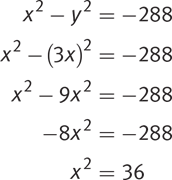
The question asks for the value of x 2, not x, so there is no need to take the square root of 36 to find the value of x. Choice (B) is correct.
2. D
Difficulty: Hard
Strategic Advice: Solving each system would be absurdly time-consuming. Backsolving will be faster.
Getting to the Answer: Substitute x = −8, the x-value at one of the points of intersection, into each equation. The correct system will have both equations equaling the same number, which is the y-value at that point of intersection. Look at each answer choice:
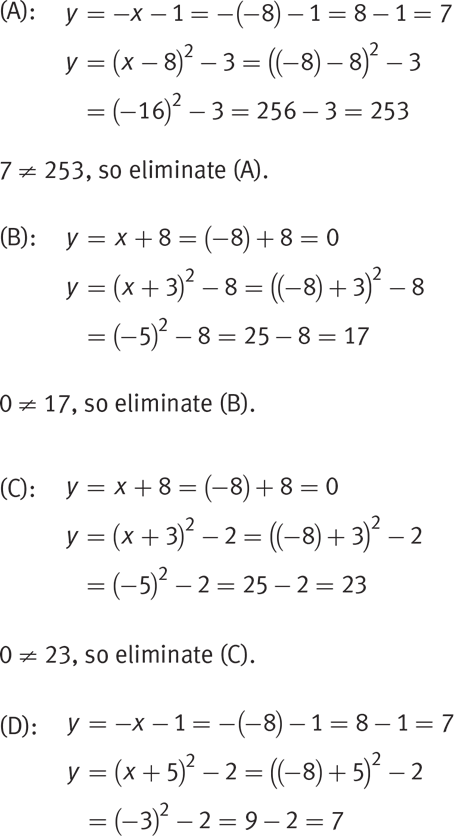
7 = 7, so the two equations in (D) intersect at the point (—8, 7). Thus, (D) is correct.
3. D
Difficulty: Hard
Strategic Advice: All of the choices present a system of equations that includes a parabola and a line. For a system of equations to have only one solution, the graphs must have only one point of intersection.
Getting to the Answer: Notice that all of the choices have the same parabola with a vertex of (−3, −5). Choices (B) and (D) have horizontal lines, which are easy to check. Choice (B) has a horizontal line at y = 5, but with the parabola facing downward, the parabola will never intersect it. Choice (D) has a horizontal line at y = −5, which is where the parabola’s vertex lies. This means the line is tangent to the parabola and will touch the parabola only once to create only one solution. Thus, (D) is correct. For the record, (A) has two points of intersection and (C) has none.
4. C
Difficulty: Hard
Category: Systems of Quadratic and Linear Equations
Getting to the Answer: If this question is in the calculator section, you can graph the two functions simultaneously and observe that they intersect each other twice. If you are not visually sold on what the correct answer is, you can do a little investigating by using your calculator to tell you the values of the vertex (the minimum) and the points of intersection.
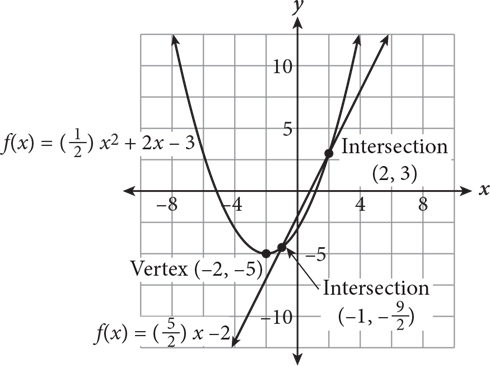
If this is in the non-calculator section, you’ll instead need to solve this by hand by setting the two equations equal to each other to see whether they intersect and, if so, how many times:
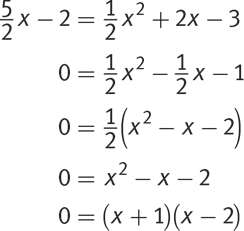
You’ll see that the functions do intersect each other at two locations, x = −1 and x = 2. You now need to determine the location of the vertex to compare. Using the formula given for the x-coordinate of the vertex (h), you can do this quite easily:

You need not calculate the y-coordinate (k) because you already have the answer. Both of the points of intersection, −1 and 2, occur to the right of the vertex. The answer is (C).
1. B
Difficulty: Medium
Category: Graphs of Quadratics
Getting to the Answer: Set f(x) equal to g(x): 2x2 − 5 = 6x2 − 7. Isolate the x2 terms on one side to get 2 = 4x2, so x2 = ![]() . Take the square root of both sides to see that
. Take the square root of both sides to see that  , which means that the two intersections of the functions occur when
, which means that the two intersections of the functions occur when  and
and  . None of the choices match, so multiply the numerator and denominator by
. None of the choices match, so multiply the numerator and denominator by ![]() to convert these to
to convert these to  . From the graph, you can see that these are the values of ±z, so
. From the graph, you can see that these are the values of ±z, so  . (B) is correct.
. (B) is correct.
Alternatively, you could plug in the coordinates of one of the intersections into either function. Using f(x), the y—coordinate is −4 and the x-coordinate is z. So, −4 = 2z2 − 5. The math works out exactly the same as for the first approach: z2 = ![]() , so
, so  , and, from the graph, you can determine that
, and, from the graph, you can determine that  . Again, (B) is correct.
. Again, (B) is correct.
1. B
Difficulty: Easy
Category: Graphs of Quadratics
Getting to the Answer: Sketch a regression line on the graph. You’ll notice it has a slight curve. Extending the regression line to the x-axis allows you to reasonably estimate what your fuel economy at 100 miles per hour (mph) will be. Notice that the miles per gallon (mpg) drop from 80 mph to 90 mph is slightly less than 10, so it is reasonable to expect a drop of another full 10 mpg as the curve steepens from 90 mph to 100 mph. Therefore, the mpg at 100 mph would be about 10, so (B) is correct.
2. 5
Difficulty: Easy
Category: Solving Quadratics by Factoring
Getting to the Answer: Factor the given quadratic by finding factors of 20 that add, or subtract, to get the middle constant 9. Notice that −4 and −5 will multiply to get 20 and add to get −9. So, x2 − 9x + 20 = (x − 4)(x − 5). Set both equal to 0 and solve for x to get x = 4 and x = 5. Remember that the question asks for m, where m > n, or in other words for the larger of the two roots, so grid in 5.
3. D
Difficulty: Hard
Category: Graphs of Quadratics
Getting to the Answer: Look for an equation among the choices that has a maximum value that is less than the maximum height of Shawna’s toss. To determine the peak height of Shawna’s throw, convert the given equation to vertex form, y = a(x — h)2 + k, where the maximum value is given by k. Notice that the polynomial within the parentheses factors to (t − 2)2. Thus, you can restate the given equation as −5(t − 2)2 + 22. So the vertex of the equation for Shawna’s throw is (2, 22), which means that the maximum height was 22 meters.
Conveniently, the choices are all stated in vertex form. The only one with the k term less than 22 is (D), which makes that the correct choice. (Notice that this equation differs from the restated version of the given equation only by the k term.)
4. C
Difficulty: Medium
Category: Graphs of Quadratics
Getting to the Answer: When a quadratic equation is written in vertex form, y = a(x − h)2 + k, the minimum value (or the maximum value if a < 0) is given by k, and the axis of symmetry is given by the equation x = h. The question states that the minimum of the parabola is −3, so look for an equation where k = −3. You can eliminate choices (A) and (B) because k = 2 in both equations. The question also states that the axis of symmetry is x = 2, so h must be 2. Be careful: this can be tricky. The equation in choice (D) is not correct because the vertex form of a parabola includes the term (x − h) not (x + h), so (x + 2) should be interpreted as (x − (−2)), with axis of symmetry at x = −2. This means (C) is correct.
5. C
Difficulty: Medium
Category: Solving Quadratics by Factoring
Getting to the Answer: Rearrange the equation into the standard quadratic form by subtracting everything from the right side of the equal sign: ![]() . Next, divide the equation by 2 to make factoring easier:
. Next, divide the equation by 2 to make factoring easier: ![]() . Now, use reverse FOIL to determine the factors. You need factors of 12 that sum to −7. Those are −3 and −4, so your equation factors to (x — 3)(x — 4) = 0. That means the solutions to the equation are x = 3 and x = 4. Since only one of these is among the answers, (C) is correct.
. Now, use reverse FOIL to determine the factors. You need factors of 12 that sum to −7. Those are −3 and −4, so your equation factors to (x — 3)(x — 4) = 0. That means the solutions to the equation are x = 3 and x = 4. Since only one of these is among the answers, (C) is correct.
6. C
Difficulty: Hard
Category: Completing the Square
Getting to the Answer: First divide both sides by 4, so that 4x2 − 8x + 64 = 0 becomes x2 − 2x + 16 =0. Notice that this cannot be solved by factoring, so use the completing the square method:
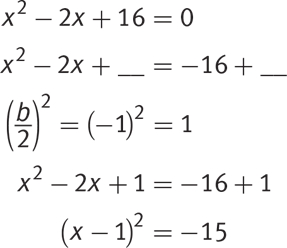
Therefore, (C) is correct.
7. A
Difficulty: Medium
Category: Classic Quadratics
Getting to the Answer: Notice that this quadratic is a difference of squares, so use the formula a2 − b2 = (a + b)(a − b). Set a2 equal to 64x2 and take the square root of both sides to find that a = 8x. Do the same thing with b2 and 81y2 to find that b = 9y. Fill in (a + b)(a − b) with the values you found for a and b to get (8x + 9y)(8x − 9y). Therefore, (A) is correct.
8. D
Difficulty: Hard
Category: Quadratic Formula
Strategic Advice: The discriminant is the part of the quadratic formula that determines whether a quadratic equation has 1 or 2 distinct real solutions or only imaginary solutions. Note that a quadratic will have only one distinct real solution when the discriminant equals 0.
Getting to the Answer: Convert the equations to standard quadratic form, if necessary, and calculate the discriminant for each choice to see which one equals 0:
(A) converts to 4x2 − 3x + 8 = 0. The discriminant is (−3)2 − 4(4)(8) = 9 − 128 = —119. This is not equal to 0, so eliminate (A).
(B) converts to x2 + 10x − 2 = 0. The discriminant is (10)2 − 4(1)(−2) = 100 + 8 = 108. Eliminate (B).
(C) is already in the proper form. The discriminant is (2)2 − 4(7)(−5) = 4 + 140 = 144. Eliminate (C).
Only (D) is left, so it is correct. For the record, the discriminant for (D) does, in fact, equal 0. Divide through by the common factor of 3 to get x2 — 2x + 1 = 0, so the discriminant is (−2)2 −4(1)(1) = 0.
9. 9
Difficulty: Hard
Category: Systems of Quadratic and Linear Equations
Getting to the Answer: Rearrange both equations to isolate y in terms of x:

Set both equations equal to each other to find where they intersect. Combine like terms on one side of the equation:

This quadratic equation can be solved by factoring since two factors of −14, 7 and −2, add to 5. Hence, (x + 7)(x − 2) = 0 and x = −7 and x = 2. The question asks for the absolute difference, so subtract the roots and evaluate as an absolute value:
![]()
Grid in 9.
10.A
Difficulty: Hard
Category: Completing the Square
Strategic Advice: Vertex form is usually a good option when questions ask for coordinates of the vertex. One of the best methods to convert quadratic equations into vertex form is completing the square.
Getting to the Answer: The x2 term has a coefficient of 1, so no manipulation of the equation is necessary before completing the square. Move the constant term to the right side of the equation before dividing the x-term’s coefficient by 2 and squaring:
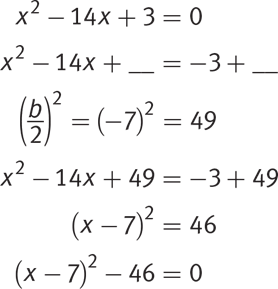
Now the equation y = (x − 7)2 − 46 is in vertex form, y = a(x − h)2 + k, where the vertex is (h, k). To find the x-coordinate of the vertex, or h, be aware of the negative sign before h in vertex form. In this case, −h = −7, so h = 7. Only (A) has an x-coordinate of 7, so it must be correct.
For the record, the y-coordinate, or k, of the vertex is −46. The vertex therefore is (h, k) = (7, −46), so (A) is indeed correct.



